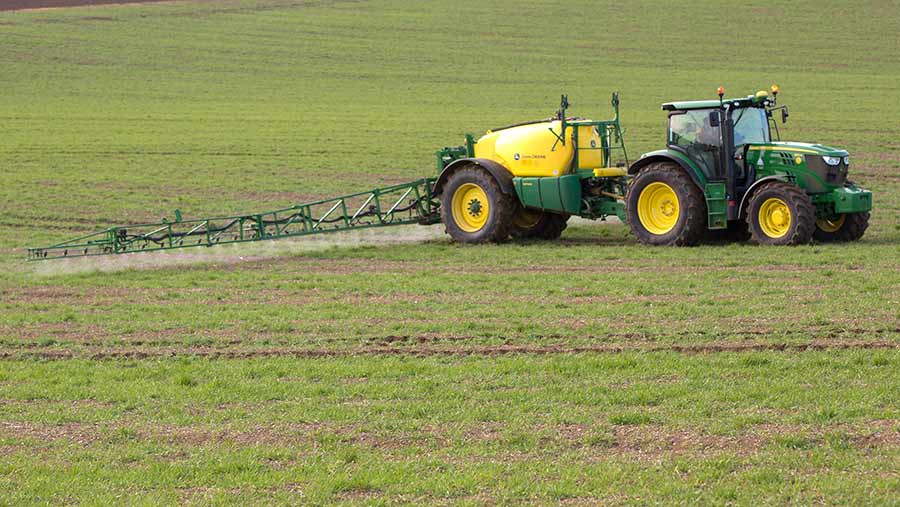Crop Watch: Timing of fungicide applications critical
 © Tim Scrivener
© Tim Scrivener The arrival of the spring equinox and the hefty workload that goes with the changing of the season means that getting jobs in order of priority is crucial for our agronomists this week.
The maize season will shortly be kicking off in the West, and Giles Simpson outlines the preparations that should be starting now.
A robust growth regulation programme will be needed for winter wheat, but Patrick Stephenson is grateful for new varieties offering more flexibility with septoria control for growers in the North.
See also: Advice on managing septoria resistance
In the East, Marcus Mann has some advice on the best strategy for getting nitrogen into forward oilseed rape crops.
However, in the South, Kevin Knight offers a word of caution if using ammonium nitrate, as there is evidence that it can have an impact on boron uptake.
West: Giles Simpson
Pearce Seeds (Somerset)

Giles Simpson
Most of the winter barley crops should have had their T0 spray by now. This has been a robust mixture of fungicide and growth regulator, with some crops getting manganese if they needed it. These crops are now moving quickly, having had fertiliser a couple of weeks ago.
It’s nice to come through the winter and only have one field that needs attention through lack of crop – this was a field drilled with over-yeared seed.
Although the germination test was good, the crop lacked vigour and the rooks and slugs played havoc, some spring wheat will be direct drilled into this crop and it will then go for wholecrop.
Most winter wheat crops are now at T0, some of the late sown wheats behind maize are not quite there, but recommendations are on farm and will be sprayed in the next week, weather permitting.
Septoria is the main disease to be controlled in the South West, and there is plenty present at the moment, full rate chlorothalonil and triazole with a good growth regulator will be used.
Weed control in general has been good but there are wild oats appearing in some crops and these will need to be dealt with to avoid competition.
Foundations for maize
As we get close to maize drilling, make sure fields are soil tested. Make sure pH, phosphate and potash levels are all corrected if need be.
Dig a hole to check for any compaction, and monitor the soil temperature – checking it at the same time every day. When we get to mid-April and soil temperatures are 10C and rising, then drilling can commence.
Make sure seed-beds are good, and drilling is carried out correctly to gain even depth and distance between seeds, as this has a huge effect on overall yield.
I will be, where possible, doing pre-emergence weed control on the maize crops to reduce early weed pressure.
North: Patrick Stephenson
AICC (Yorkshire)

Patrick Stephenson
Top dressing with nitrogen and sulphur has been the priority, with winter barley now desperate for a decent amount of nitrogen to keep tillers.
Autumn broadleaf weed control has been outstanding in the cereals with only minor bits of tidying up to do. Spring grass weed control programmes will start now that the temperature has risen.
Winter barley crops on the whole look good and will receive a growth regulator and T0 spray in the next few days.
Applying a T0 enables the T1 spray to be delayed and ensures that the T2 spray covers the ear, thus giving good disease protection all season. Prothioconazole and SDHI will be the core treatment for T1.
Yellow rust in Claire
It was disappointing to find yellow rust active in a crop of Claire this week. Early disease outbreaks always bring a dilemma of when do you start your fungicide programme?
Triazoles are still very active against yellow rust and provide good cost-effective protection. One thing is certain – once you have applied a fungicide you have become a hamster on a spinning wheel.
All new growth needs protecting and spray intervals should not exceed 25 days, so my advice is don’t start to early.
The new varieties Siskin and Graham are providing us with good septoria resistance ratings and will hopefully enable us to have more flexibility in our spray programme.
Some of the early wheat is very lush and a comprehensive growth regulation programme will be implemented to ensure they remain standing.
Spring drilling has yet to start in earnest and, with a huge area to be drilled, patience is starting to wear thing.
Cover crops are a mixed blessing at this time, appearing to harbour moisture rather than use it. Time will tell if they bring the long-term soil benefits that we hope for.
East: Marcus Mann
Frontier (Essex)

Marcus Mann
The last few weeks have seen crops start to move, aided by increase in day length and a quick rise in soil temperatures. Previous field cropping history is also evident; cereals following pulses or winter oilseed rape have picked up more residual nitrogen and are much more forward and tillering well.
Bear this in mind this year, as the higher soil nitrogen indices may allow the total dose to be reduced.
Winter wheat is approaching GS30, and T0 sprays have been planned for the final week of March. At present septoria remains the main disease concern. However, yellow rust is being discovered in the more susceptible varieties (Reflection, Solstice).
Strategies will be based on triazole+chlorothalonil to dry up any active rust and offer protective activity against septoria until the T1 timing.
Late drilled crops and second wheats will also have a growth regulator applied to encourage further root stimulation. Canopy (mepiquat+prohexadione) will be the preferred option under cooler conditions.
Recent approval of Zypar (florasulam+Halauxifen) gives further options for cleaver control and difficult broadleaved weeds such as groundsel and cranesbill. This also has approval in spring cereals (excluding oats).
Oilseed rape nitrogen options
Winter oilseed rape nitrogen was delayed due to wet travelling conditions and now applications have coincided with a vigorous growing crop.
It is critical to ensure this goes on before the canopy grows too far, to reduce the impact it may have on the spread pattern.
If the doses become large and impractical to apply, it is worth considering a liquid dose later on, which will allow 40kg of N to be applied to the pods.
Not only does this increase greening, encouraging further photosynthesis and building yield but it also allows a reduced earlier dose to be factored in. Pollen beetle migration into crops has begun, although the main influx will occur once temperatures exceed 15C.
The way the crops are growing they should get through the susceptible period quickly, but it is still worth monitoring.
South: Kevin Knight
Zantra (Kent)

Kevin Knight
Spring planting is thankfully being completed in mostly fine conditions and, wind permitting, spray applications and top dressing has been well timed.
There is evidence that ammonium sulphate can cause antagonism with boron uptake – oilseed rape needs adequate levels during bud initiation and early flowering.
An autumn application is advisable on deficient soils, then another at early stem extension and an early flowering top up. Of the three, the stem extension timing is most critical, and applying 350g of the total boron requirement here is a sound approach.
The later flowering application can coincide with a sclerotinia fungicide and insecticide for weevil/pod midge. If using Mavrik (tau-fluvalinate), note that tank mixing with boron is a disaster best avoided.
Pollen beetle numbers have built over recent days but are nowhere near threshold levels on oilseed rape.
I remain unconvinced that grazing of unopened buds causes any significant yield knock in the majority of seasons. As so many buds abort in the absence of beetle damage it seems unlikely, particularly when considering potential yield gains from higher pollinator numbers.
However, spring oilseed rape is more vulnerable at key growth stages when beetle numbers are at their highest and should be treated where thresholds are reached.
Fungicide timings
T0 applications will start on mid-September drilled wheat later next week, but many late drilled/second wheats won’t have leaf four fully emerged until April.
I am inclined to hold off until the right growth stage rather than apply to leaf five, leaving leaf four unprotected, and have too big a gap to T1 allowing disease to travel up the plant.
Most crops are looking in good order, with precious little rain splash in my area to spread septoria. In higher plant populations there is a little mildew so some T0 recommendations will include a mildewicide (cyflufenamid).
Bean drilling is completed and peas almost done. Note that from next March it seems likely that the use of pesticides will be banned in Ecological Focus Areas – consider this if planning pulse crops to fulfil your area requirements next season.

